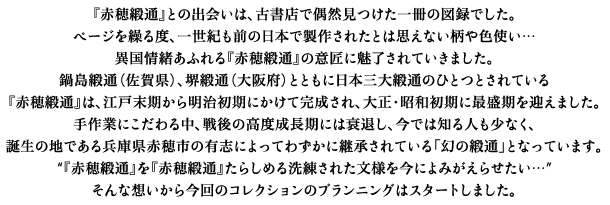





緞通の製造技術が、本格的に日本に持ち込まれたのは、江戸時代の元禄の頃とも伝えられています。この技術を用いて全国各地で独自の緞通がつくられるようになったといわれています。そんな中、模様の意匠にもさまざまな工夫がこらされていきました。ペルシャや中国の文様を模倣するのではなく、独自の文様が創案されていったのです。『赤穂緞通』も例外ではなく、独自の文様を模索していました。江戸時代が幕を閉じ、明治時代がはじまると政府は、緞通輸出に期待し、技術向上を奨励しました。明治7年には、正倉院御物が参考見本として公開されています。このように関係するさまざまな人たちの創意努力によって、オリエンタル文化と融合した日本文化として、新しい物語を語りはじめていたのです。
It is said that the technology of Dantsu making was officially introduced to Japan in the Genroku era (early Edo period), and unique Dantsu began to be made with this technology in various parts of Japan. Meanwhile, the patterns were designed with great creativity. They didn’t imitate the Chinese patterns, but invented their original patterns. “Ako Dantsu” was no exception, and was seeking unique patterns. As the Edo period ended and the Meiji period began, the government encouraged technology improvement in expectation of export of the Dantsu. The imperial treasure kept in Shosoin was shown to the public as reference samples in the 7th year of Meiji period (1874). In this way, the inventive ideas and efforts of the people involved started the new story of “Ako Dantsu” as the Japanese culture, a mixture of Oriental and Japanese culture.
-

GORYO - MON

唐花を中心にして美しい曲線の蔓草で構成されているこの文様は、かつて「御寮」と呼ばれ、明治から昭和にかけて天皇・皇后の御召列車、東宮御船、枢密院玉座用の敷物として皇室に納められていたと思われる。
The pattern of beautiful, curved scrolling vine around Chinese flowers used to be called “Goryo”. It seems to have been presented to the Imperial family as carpets for the Imperial train and the Crown Prince’s boat, and the throne seat of the Privy Council.
-

RIKEN - MON

赤穂緞通に古くからある利剣文には、いくつかのバリエーションがある。利剣とは鋭利な剣を意味し、煩悩や悪魔を打ち破る仏の智慧、邪悪なものを打ち破る意味がこの文様には込められている。
The pattern, which has existed among “Ako Dantsu” through the ages, has some variations. Riken literally means a sharp sword, and it also means the Buddha’s wisdom to defeat worldly desires and evil spirits and defeating the evil.
-

KIRIKARAKUSA - MON

主文様と縁文様が組み合わされたものが多い中で、縁のない桐唐草文。桐は鳳凰がとまる木として神聖なものとされていた。そのため皇室や有力武将に用いられ、高貴な文様とされていた。
While many other patterns are combinations of a main pattern and a pattern frame around it, “Kirikarakusa-mon” has no pattern frame. Paulownia tree was considered a holy tree on which phoenix perches. So the pattern was used by the Imperial family and strong warlords and considered a holy pattern.


児嶋なかは文政6年(1823)赤穂郡中村(赤穂市中広)で生まれました。彼女は夫と讃岐国高松を訪れた時、万暦氈(ばんれきせん)という中国緞通に出会い、その色合いの美しさと図柄の精巧さに感動そして、炬燵の櫓を倒して織機とすることを思いついたのです。綿糸を用いて幅5寸(15㎝)、長さ3寸(9cm)の小さなものを織ったのが、嘉永2年(1849)のことです。その後も、彼女は図案や配色などの資料収集のため、四国、九州や中国へ赴き、試行錯誤を繰り返しながら緞通の研究を重ねていきました。
Kojima Naka was born in Nakamura, Ako-gun (currently Nakahiro, Ako-shi) in 1823. She first met Chinese Dantsu called “Banrekisen” when she visited Takamatsu in Sanuki area with her husband. She was impressed by its beautiful color and ellaborate pattern and she devised a way to make a weaving loom using the frame of a kotatsu (a low table with a heat source) laid on its side. It was in 1849 that she made a small piece of fabric, 15 cm wide and 9 cm long, from cotton yarn. After that, she visited Shikoku, Kyushu, and Chugoku area to collect data on patterns and color combination to study Dantsu through trial and error.


苦労の末、座布団大のものを織り上げたのは、明治3年(1870)のことでした。そして、四年後の明治7年(1874)1畳敷織の大機を作り、営業化にこぎつけました。「児嶋なか」が緞通に取り組んでから、実に26年後のことでした。彼女はその後も、3畳敷織、6畳敷織、12畳敷織の織機を作ったり、文様を考案するなど製造と改良に力を尽くしました。
In 1870, she finally finished weaving a piece of cloth the size of Zabuton cushion. Then, 4 years later in 1874, she made a bigger weaving loom for tatami size fabric and launched sales. It was 26 years after Naka started to work on Dantsu. Thereafter, she was fully committed to production and improvement, creating 3-tatami loom, 6-tatami loom, and 12-tatami loom and designing patterns.

赤穂は古くから塩の生産地として広く世に知られていますが、実は赤穂緞通は塩田と深く関わっています。広大な塩田を擁する御崎地区では、男も女も塩田で働くものとなっていましたが、この地に緞通場ができると、女は緞通場で働くようになりました。十分な労働力に支えられ、赤穂緞通は急速に広がっていきました。
Ako has long been widely known for its salt. “Ako Dantsu” is deeply related to salt fields. Both men and women had usually been working in the salt fields in Misaki district. But, as Dantsu factories were built, the women started to work there. With the sufficient labor supply, “Ako Dantsu” spreaded rapidly.

明治31年(1898)には赤穂郡内織元8軒、織機大小計100台、職工176名まで拡大。児嶋なかによって開発された赤穂緞通は、技法・意匠・品質の改良を重ね、ついには高い評価を得て天皇の御召列車の敷物として採用されることになります。その後も、東宮御船用、枢密院玉座の敷物として政府に納入されました。
In the 31st year of the Meiji period (1898), there were 8 weaving factories, 100 large and small weaving looms, and 176 weavers in Ako. “Ako Dantsu”, developed by Kojima Naka, was repeatedly improved in technique, design, and quality. It came to be highly regarded and used as the carpet for the Imperial train. Even after that, it was delivered to the government as carpets for the Crown Prince’s boat, and the throne seat of the Privy Council.

1900年代になり緞通業で生業が成立するようになると、織元も増え、多くの織子を抱えるほどになります。やがて販路も海外まで発展し、ニューヨーク、ロンドン、オーストラリアにまで広がりました。赤穂緞通の最盛期です。
When they came to make a living with Dantsu business in the 1900’s, the number of weaving factory and weaver increased. Eventually, they developed overseas market to New York, London, and Australia. It was the peak of “Ako Dantsu”.

昭和13年(1938)の国内での原綿事情の悪化に加え、戦争により綿花輸入制限を受けて、緞通場は次々と閉鎖を余儀なくされ衰退の一途をたどるのです。戦後、緞通業を再開する織元も現れましたが、高度経済成長の真っ只中で大量生産の時代に、手作業の赤穂緞通は生き残ることができず、ついには残る織手はただ一人となり、伝統の技術は絶える危機にありました。
In addition to the worsening raw cotton situation, import restrictions were imposed on the Dantsu factories under the influence of the war. The factories were forced to close one after another, and the industry followed a course of decline. Some factories reopened after the war, but “Ako Dantsu” , made by hand work, couldn’t survive the age of mass production in the midst of rapid economic growth, which left only one weaver, and the traditional technology was disappearing.

平成3年(1991)赤穂市は、消えゆく伝統技術を後世に伝えるべく「赤穂緞通織り方技法講習会」を開設しました。そこで技術を習得した人たちが立派な織手となり、市内各所に工房を開設して、伝統工芸の保存及び技術の伝承に取り組んでいきます。一度は絶えかけた伝統工芸は、彼女たちの努力によってよみがえったのです。
In 1991, the city of Ako started “Training Session on Weaving Technology of Ako Dantsu” in order to pass the declining traditional technology down the generations. Those who have studied there make great weavers, and open their own workshops to preserve the traditional handicraft and pass down the skills. As the Dantsu they weave is replication of old patterns as well as up to date, they are drawing people’s attention. The traditional handicraft, which nearly disappeared at one point, has come back thanks to their efforts.

工房ひぐらしには2人の織り手がおり、それぞれ自宅に機場を作って制作しています。かつて多くの緞通場があった赤穂御崎には「赤穂緞通ギャラリーCAPEHOUSE(ケイプハウス)」があり、実際の赤穂緞通も購入することが出来ます。今後もイベントや展示会を積極的に行うことで緞通の魅力をさらに広め、新しい未来の担い手へと受け継がれていきます。
Kobo Higurashi has two weavers. Each of them works on their own weaving mill at their home. “Ako Dantsu Gallery CAPE HOUSE” is located in Ako-misaki, where many Dantsu factories used to be. You can purchase actual “Ako Dantsu” there. We’ll actively hold events and exhibitions to popularize the charm of Dantsu and hand it over to the future bearers of the culture.
























